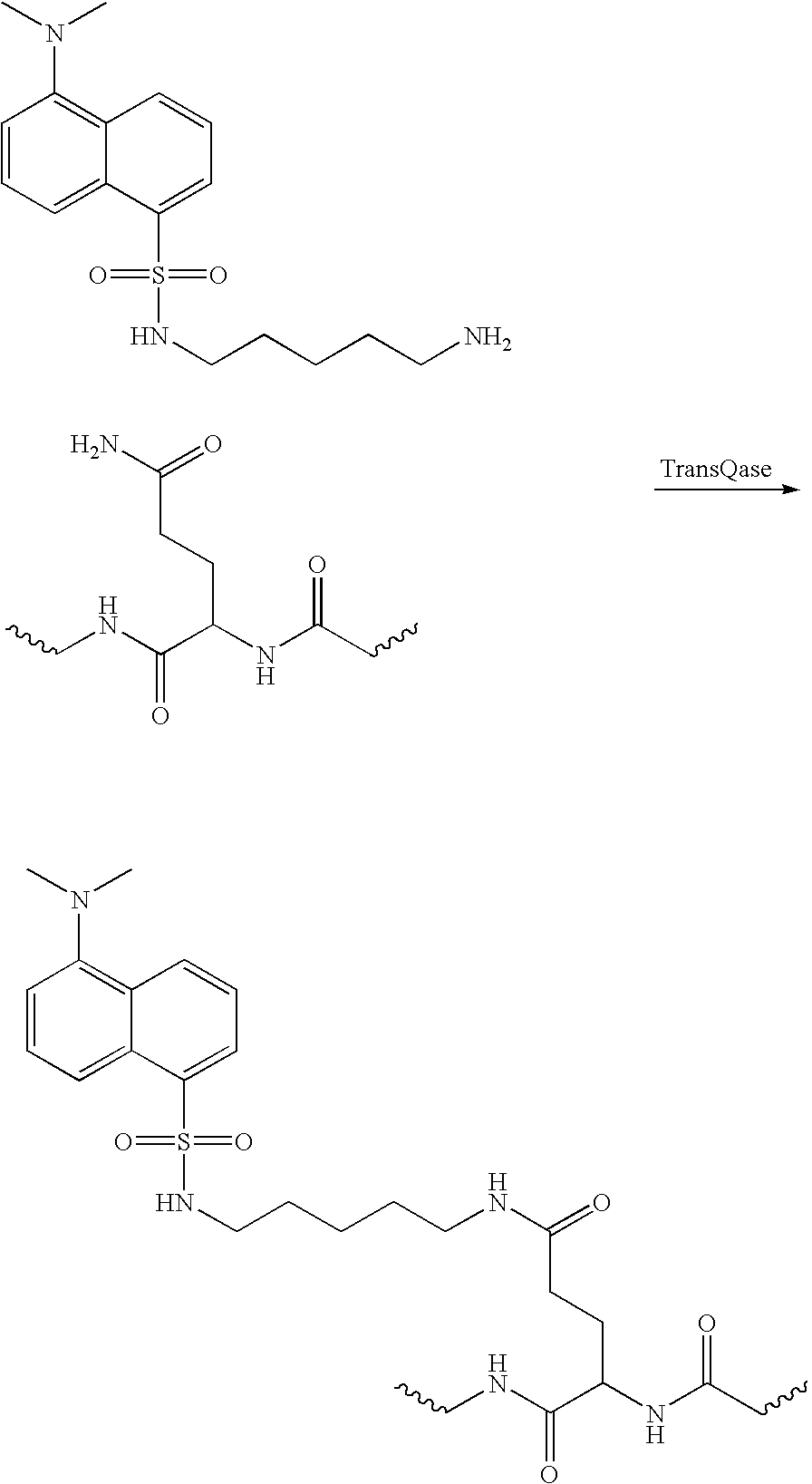Method of site specific labeling of proteins and uses therefor
a protein and site specific technology, applied in the field of methods, can solve the problems of cumbersome use, limited methods to the labeling of a particular protein, and difficult to obtain predictable labeling or label a protein without detrimentally affecting the binding or other activity of the protein
- Summary
- Abstract
- Description
- Claims
- Application Information
AI Technical Summary
Benefits of technology
Problems solved by technology
Method used
Image
Examples
example 1
[0058] Several peptide sequences that include a glutamine residue were tested as substrates for transglutaninase. The peptide sequences were based on sequences that are known to be substrates for Factor XIII, a commercially available transglutaminase [Enzyme Research Laboratories]. The following are examples of peptide sequences that were efficiently labeled; derivatives of these sequences were then engineered into proteins:
[SEQ ID NO:4]Peptide 1:NH2-Leu-Ser-Leu-Ser-Gln-Ser-Lys-Val-Leu-Gly-NH2[SEQ ID NO:5]Peptide 2:NH2-Ile-Gly-Glu-GIy-Gln-Ser-Lys-Val-Leu-Gly-NH2[SEQ ID NO:6]Peptide 3:NH2-Leu-Gly-Pro-Gly-Gln-Ser-Lys-Val-IIe-Gly-NH2
[0059] A variant of the above described Peptide I sequence was engineered onto the N- and C-termini of E. coli acyl carrier protein (ACP). Both engineered ACPs could be over expressed as soluble proteins in E. coli. Analysis of the overexpressed engineered ACPs showed that they were present as a mixture of apo and holo proteins.
[0060] The presence of hol...
example 2
Improved Biotinylation Reagents
[0092] The ACP-peptide 1 C-terminal fusion was labeled with biotin cadaverine (Molecular Probes) in a reaction mixture of 0.5 mg / ml ACP-Peptide 1 fusion, 1.5 mM biotin-cadaverine and 504 units / ml Factor XIIIa. The efficiency of incorporation was determined by competitive ELISA to be 56%.
[0093] Novel biotinylation reagents (i.e. labeling compounds) were tested in an attempt to increase the yield. To this end, two biotinylated dipeptides, Biotin-Trp-Lys-OH and Biotin-NitroTyr-Lys-OH, were evaluated in a reaction mixture of 0.5 mg / ml ACP-Peptide 1 fusion, 1.5 mM biotin-cadaverine and 504 units / ml Factor XIIIa. Incorporation of the Biotin-Trp-Lys-OH dipeptide was shown by Mono Q ion exchange to be >85% (FIG. 2), in comparison to a 55% incorporation of the Biotin-NitroTyr-Lys dipeptide (FIG. 1). FIG. 2 provides the C-tagged ACP standard. The identity of the modified peak was confirmed by addition of unmodified ACP at the end of the reaction (FIG. 4).
example 3
Construction, Purification and Labeling of Q-Tagged FabH
[0094] An N-terminally Q-tagged Streptococcus haemophilus FabH gene construct was made by PCR amplification from a previously cloned FabH cDNA. The 5′ primer, SEQ ID NO:13,
[0095] contained an NdeI restriction site (underlined) followed by the sequence encoding the Q-tag-LSLSQSKVLPGP-(SEQ ID NO:12, DNA sequence, double underline). This oligonucleotide annealed to the 5′ end of the FabH cDNA, omitting the initiating Met residue (bold, boxed DNA sequence). The 3′ primer, SEQ ID NO:14:
annealed to the 3′ end of the FabH gene (boxed, bold sequence) and included a stop codon (double underline). This primer contained a BglII site for cloning (underlined).
[0096] The Q-tagged FabH PCR product was amplified with Klen Taq HF polymerase (Clontech) and cloned into a T-vector (pCR2.1, Invitrogen) using standard methodologies. Following confirmation of the sequence by dideoxy sequencing, the Q-tagged FabH DNA was cloned into pET−16b [No...
PUM
| Property | Measurement | Unit |
|---|---|---|
| Fraction | aaaaa | aaaaa |
| Mass | aaaaa | aaaaa |
| Fluorescence | aaaaa | aaaaa |
Abstract
Description
Claims
Application Information
 Login to View More
Login to View More - R&D
- Intellectual Property
- Life Sciences
- Materials
- Tech Scout
- Unparalleled Data Quality
- Higher Quality Content
- 60% Fewer Hallucinations
Browse by: Latest US Patents, China's latest patents, Technical Efficacy Thesaurus, Application Domain, Technology Topic, Popular Technical Reports.
© 2025 PatSnap. All rights reserved.Legal|Privacy policy|Modern Slavery Act Transparency Statement|Sitemap|About US| Contact US: help@patsnap.com



